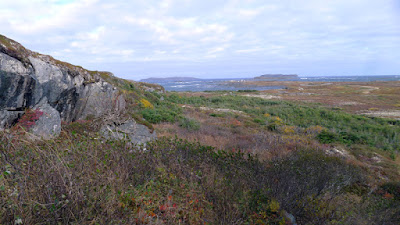
The wreckage of the SS Ethie is strewn across the beach at Martin’s Point.
The steamer SS Ethie set sail from Cow Head, on the Great Northern Peninsula of Newfoundland, on December 10, 1919. Although Captain Edward English knew that some kind of storm was building, it was the last trip of the season, and he was under pressure to get his passengers home for Christmas.
Within a few hours, the storm blew up into a blizzard. The Ethie was making no progress, burning almost all of her coal just staying off the rocky ledges and bars of the coastline. Captain English knew his ship was lost; his priority now was to get the 92 people on board to shore alive.
Number one thing I am thankful for tonight: I am not on that freighter.
He beached the Ethie just north of Sally’s Cove, in one of the few inlets not barred by reefs or cliffs. His crew sent out a rope, which was picked up by a local Newfoundland dog. A breeches buoy was rigged up to carry the passengers and crew ashore, including a baby girl who rode to shore in a mail sack. There were no fatalities.
The dangers of the Great White North are based in the land itself, in its impossible cold and empty vastness. On the Atlantic Coast, the sea is the force that controls lives. The remains of the Ethie are still strewn along the beach and I wanted to paint it.

Stunted trees in the Gros Morne National Forest. This is the beginning of the Appalachian mountains.
I hit the road from Botwood before dawn. The remnants of Hurricane Matthew had confounded expectations and run up the Atlantic Coast. Our ferry was canceled. We had an extra 24 hours to use as we pleased—as long as what we pleased was possible in a storm.
Studded snow tires are like an arms race. They work, but they also chew ruts into the road. The water runs into them, causing water to pool and freeze, creating more potholes and ice. The ruts have plagued me since Anchorage, as they make steering difficult.
They also fill with water in heavy rain. In the half light of a storm, they are difficult to track. After several hours, my hands were knotted around the wheel.

The shoreline ranges from ledges to cliffs.
By the time we reached the Ethie, it was clear I was going to do no painting. Needles of sleet were driven by high winds. I took reference photos and debated my next move.
My friend Annette found me a haven with one of her many relatives. Mary wanted to push farther north to see the Viking encampment at
L’Anse aux Meadows. What a dilemma: eat Thanksgiving pie with nice people in warmth and comfort, or push through another 350 km to see a desolate and windswept headland in a storm?
Need you even ask?
It got steadily worse as we went north. Sleet was followed by snow. We saw our first sanders of the season. The wind blew so hard that even the potholes had little waves on them. Crosswinds blew our car sideways. And I learned that hydroplaning and cruise control were a difficult combination.

Trawlers at a boatyard in Port Saunders, Newfoundland.
We stopped in Port aux Choix for our Canadian Thanksgiving dinner: gas station hot dogs and coffee. The clerk, a very lovely woman, discouraged us from heading any farther north. “There’s a lovely B&B down the street,” she suggested.

We slid into St. Anthony behind a sander. Still, I had to put the SUV in 4WD to park it.
We arrived in St. Anthony right behind a sander. We’re drinking bottled water because of the storm, but otherwise we’re warm and cozy. Tomorrow we will head to L’Anse aux Meadows. Mary is going to tromp around and consider the Vikings. If I’m lucky, the wind will slow down and I can paint.
But I’m absolutely certain we won’t be home by Wednesday.
















